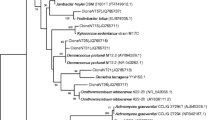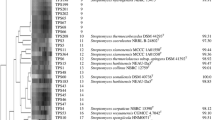Abstract
A culture-independent nested polymerase chain reaction (PCR) technique was used to investigate the diversity of actinobacteria communities associated with the sponges Hymeniacidon perleve and Sponge sp. The phylogenetic affiliation of sponge-derived actinobacteria was then assessed by 16S rRNA sequencing of cloned DNA fragments. A total of 196 positive clones were screened by restriction fragment length polymorphism (RFLP) analysis; 48 unique operational taxonomic units (OTUs) were selected for sequencing. Rarefaction analysis indicated that the clone libraries represented 93% and 94% of the total estimated diversity for the two species, respectively. Phylogenetic analysis of sequence data revealed representatives of various phylogenetic divisions, which were related to the following ten actinobacterial genera: Acidimicrobium, Corynebacterium, Propionibacterium, Actinomyces, Micrococcus, Microbacterium, Streptomyces, Mycobacterium, Cellulosimicrobium, Sporichthya, and unidentified actinobacterial clones. A sponge-specific, previously uncultured actinobacteria community grouped within the subclass Acidimicrobidae was discovered from both H. perleve and Sponge sp. Sequences belonging to Acidimicrobium in the H. perleve and the Sponge sp. clone libraries represented 33% and 24% of the clones, respectively. In the Sponge sp. clone library Mycobacterium dominated, accounting for 70% of all clones. The presence of Acidimicrobium and mycobacteria within two sponges can lay the groundwork for attempts to culture these interesting bacteria for industrial applications.


Similar content being viewed by others
References
Chun J (1995) Computer-assisted classification and identification of actinomycetes. Ph.D Thesis, Univ Newcastle, Newcastle upon Tyne, UK
Churchill SA, Harper JP, Churchill PF (1999) Isolation and characterization of a Mycobacterium species capable of degrading three- and four-ring aromatic and aliphatic hydrocarbons. Appl Environ Microbiol 65:549–552
Conn VM, Franco CMM (2004) Analysis of the endophytic actinobacterial population in the roots of wheat (Triticum aestivum L.) by terminal restriction fragment length polymorphism and sequencing of 16S rRNA clones. Appl Environ Microbiol 70:1787–1794. doi:10.1128/AEM.70.3.1787-1794.2004
Cook AE, Meyers PR (2003) Rapid identification of filamentous actinomycetes to the genus level using genus-specific 16S rRNA gene restriction fragment patterns. Int J Syst Evol Microbiol 53:1907–1915. doi:10.1099/ijs.0.02680-0
Felsenstein J (1993) PHYLIP (Phylogeny inference package), version 3.5c. Department of Genetics, University of Washington, Seattle
Gontang EA, Fenical W, Jensen PR (2007) Phylogenetic diversity of gram-positive bacteria cultured from marine sediments. Appl Environ Microbiol 73:3272–3282. doi:10.1128/AEM.02811-06
Heck KL Jr, Van Belle G, Simberloff D (1975) Explicit calculation of the rarefaction diversity measurement and the determination of sufficient sample size. Ecology 56:1459–1461. doi:10.2307/1934716
Hentschel U, Hopke J, Horn M, Friedrich AB, Wagner M, Hacker J et al (2002) Molecular evidence for a uniform microbial community in sponges from different oceans. Appl Environ Microbiol 68:4431–4440. doi:10.1128/AEM.68.9.4431-4440.2002
Hooper JNA, Van Soest RWM (2002) Systema Porifera: a guide to the classification of sponges. Kluwer Academic/Plenum, New York
Hurlbet SH (1971) The nonconcept of species diversity: a critique and alternative parameters. Ecology 52:577–586. doi:10.2307/1934145
Imhoff JF, Stöhr R (2003) Sponge-associated bacteria: general overview and special aspects of bacteria association with Halichondria panacea. In: Müller WEG (ed) Sponge (Porifera). Springer, Berlin, pp 35–58
Kawase T, Saito A, Sato T, Kanai R, Fujii T, Nikaidou N et al (2004) Distribution and phylogenetic analysis of family 19 chitinases in Actinobacteria. Appl Environ Microbiol 70:1135–1144. doi:10.1128/AEM.70.2.1135-1144.2004
Lee YK, Kim HW, Liu CL, Lee HK (2003) A simple method for DNA extraction from marine bacteria that produce extracellular materials. J Microbiol Methods 52:245–250. doi:10.1016/S0167-7012(02)00180-X
Maldonado LA, Stach JEM, Pathom W, Ward AC, Bull AT, Goodfellow M (2005) Diversity of cultivable actinobacteria in geographically widespread marine sediments. Antonie Van Leeuwenhoek 87:11–18. doi:10.1007/s10482-004-6525-0
Mincer TJ, Fenical W, Jensen P (2005) Culture-dependent and culture-independent diversity within the obligate marine actinomycete genus Salinispora. Appl Environ Microbiol 71:7019–7028. doi:10.1128/AEM.71.11.7019-7028.2005
Montalvo NF, Mohamed NM, Enticknap JJ, Hill RT (2005) Novel actinobacteria from marine sponge. Antonie Van Leeuwenhoek 87:29–36. doi:10.1007/s10482-004-6536-x
Pitcher DG, Saunders NA, Owen RJ (1989) Rapid extraction of bacterial genomic DNA with guanidium thiocyanate. Lett Appl Microbiol 8:151–156. doi:10.1111/j.1472-765X.1989.tb00262.x
Reysenbach A-L, Giver LJ, Wickham GS, Pace NR (1992) Differential amplification of rRNA genes by polymerase chain reaction. Appl Environ Microbiol 58:3417–3418
Saitou N, Nei M (1987) The neighbor-joining method: a new method for reconstructing phylogenetic trees. Mol Biol Evol 4:406–425
Schneider J, Grosser R, Jayasimhulu K, Xue W, Warshawsky D (1996) Degradation of pyrene, benz[a]anthracene, and benzo[a] pyrene by Mycobacterium sp. strain RJGII-135, isolated from a former coal gasification site. Appl Environ Microbiol 62:13–19
Stach JE, Maldonado LA, Masson DG, Ward AC, Goodfellow M, Bull AT (2003a) Statistical approaches to estimating bacterial diversity in marine sediments. Appl Environ Microbiol 69:6189–6200. doi:10.1128/AEM.69.10.6189-6200.2003
Stach JE, Maldonado LA, Ward AC, Goodfellow M, Bull AT (2003b) New primers for the class Actinobacteria: application to marine and terrestrial environments. Environ Microbiol 5:828–841. doi:10.1046/j.1462-2920.2003.00483.x
Stackebrandt E, Rainey FA, Ward-Rainey NL (1997) Proposal for a new hierarchic classification system, Actinobacteria classis nov. Int J Syst Bacteriol 47:479–491
Takahashi Y, Omura S (2003) Isolation of new actinomycete strains for the screening of new bioactive compounds. J Gen Appl Microbiol 49:141–154. doi:10.2323/jgam.49.141
Taylor MW, Mohamed NM, Enticknap JJ, Hill RT (2007) Sponge-associated microorganisms: evolution, ecology, and biotechnological potential. Microbiol Mol Biol Rev 71:295–347. doi:10.1128/MMBR.00040-06
Thompson JD, Higgins DG, Gibson TJ (1994) CLUSTAL W: improving the sensitivity of progressive multiple sequence alignment through sequence weighting, position-specific gap penalties and weight matrix choice. Nucleic Acids Res 22:4673–4680. doi:10.1093/nar/22.22.4673
Von Wintzingerode F, Göbel UB, Stackebrandt E (1997) Determination of microbial diversity in environmental samples: pitfalls of PCR-based rRNA analysis. FEMS Microbiol Ecol 21:213–229
Watanapokasin Y, Nuchfoang S, Nilwarangkoon S, Sarangbin S, Kakizono T (2002) Isolation and characterization of thermophilic benzothiophene-degrading Mycobacterium sp. Appl Biochem Biotechnol 98–100:301–309. doi:10.1385/ABAB:98-100:1-9:301
Webster NS, Hill RT (2001) The culturable microbial community of the Great Barrier Reef sponge Rhopaloeides odorabile is dominated by α-Proteobacterium. Mar Biol (Berl) 138:843–851. doi:10.1007/s002270000503
Webster NS, Wilson KJ, Blackall LL, Hill RT (2001) Phylogenetic diversity of bacteria associated with the marine sponge Rhopaloeides odorabile. Appl Environ Microbiol 67:434–444. doi:10.1128/AEM.67.1.434-444.2001
Webster NS, Negri AP, Munro Murray MHG, Battershill CN (2004) Diverse microbial communities inhabit Antarctic sponges. Environ Microbiol 6:288–300. doi:10.1111/j.1462-2920.2004.00570.x
Weisburg WG, Barns SM, Pelletier DA, Lane DJ (1991) 16S ribosomal DNA amplification for phylogenetic study. J Bacteriol 173:697–703
Zhang HT, Lee YK, Zhang W, Lee HK (2006) Culturable actinobacteria from the marine sponge Hymeniacidon perleve: isolation and phylogenetic diversity by 16S rRNA gene-RFLP analysis. Antonie Van Leeuwenhoek 90:159–169. doi:10.1007/s10482-006-9070-1
Zhang HT, Zhang W, Jin Y, Jin MF, Yu XJ (2008) A comparative study on the phylogenetic diversity of culturable actinomycetes isolated from five marine sponge species. Antonie Van Leeuwenhoek 93:241–248. doi:10.1007/s10482-007-9196-9
Acknowledgements
The authors gratefully acknowledge the financial support from the “Innovation Fund” of the Dalian Institute of Chemical Physics and the “973 Hi-Tech Research and Development Program of China” (2003CB716001). We thank Prof. Li-Jinhe of the Qingdao Institute of Oceanology at the Chinese Academy of Sciences for identifying the sponges used in this study.
Author information
Authors and Affiliations
Corresponding author
Rights and permissions
About this article
Cite this article
Xin, Y., Huang, J., Deng, M. et al. Culture-independent nested PCR method reveals high diversity of actinobacteria associated with the marine sponges Hymeniacidon perleve and Sponge sp.. Antonie van Leeuwenhoek 94, 533–542 (2008). https://doi.org/10.1007/s10482-008-9270-y
Received:
Accepted:
Published:
Issue Date:
DOI: https://doi.org/10.1007/s10482-008-9270-y




